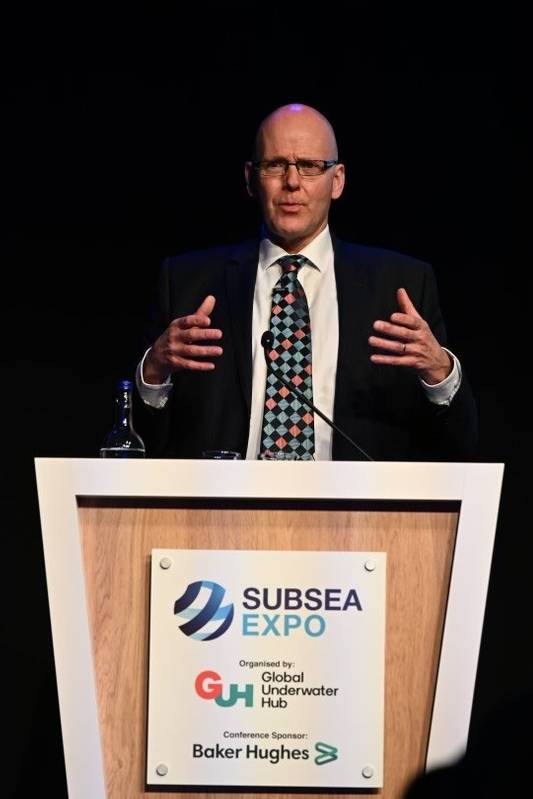
One of the first major UK industry events since the start of the Coronavirus pandemic heard Tuesday morning how, after a period of Covid-induced hibernation, the UK’s subsea sector is emerging into a new world of opportunity.
Speaking at Subsea Expo in Aberdeen, Neil Gordon, CEO of the event’s organizer, the newly formed Global Underwater Hub (GUH), said that there was a US$3 trillion global opportunity by 2030 in the blue economy that the UK’s subsea industry could target, including opportunities in defense, aquaculture and offshore renewables.
For many on the show floor, which had something of a lack of the traditional Tier 1 companies, the past two years has been an extension of the 2014-15 downturn, thanks to the pandemic.
Coronavirus restrictions, on top of reduced upstream spending, meant many companies have had to retrench, diversify or change their business model, while technology development programs have been delayed by supply chain challenges with components for the likes of electric ROVs hard to get or vastly increasing in cost.
 Global Underwater Hub CEO Neil Gordon, Image Courtesy of Global Underwater HubHowever, the challenges have also created opportunities and have meant the likes of defense organizations are more open to innovation.
Global Underwater Hub CEO Neil Gordon, Image Courtesy of Global Underwater HubHowever, the challenges have also created opportunities and have meant the likes of defense organizations are more open to innovation.
Rear Admiral Paul Halton OBE – Royal Navy Director of Submarine Support, Submarine Delivery Agency, Ministry of Defence, told the event’s plenary session that there’s been a massive change in the approach to innovation across defense operations and that innovation in the underwater industry was a key part of that.“Two and a bit years ago, no one could know what was going to happen with Covid,” he said.
“There has been a huge amount of tragedy, but a huge amount of confidence in the way the Royal Navy adapted, in ways we never thought possible, and that’s given confidence in the way we deliver maintenance and support for submarines. We’re able to tap into innovation we thought was out of reach just a couple of years ago.
“In 2016, through the Unmanned Warrior exercise, industry came together and showed us what was possible. In that, we saw the roots of some really exciting developments we are starting to see in Royal Navy (now),” such as offboard systems and mine hunting capabilities with uncrewed vehicles, he says.
“In my world, submarine maintenance, we’re starting to really get to grips with how some of the innovative solutions out there can improve maintenance of submarines. We now conduct everything from heavy engineering, which was only ever done in the dock before, to surveying hulls and internal tanks, some with divers and some with ROVs. There’s a real potential to do even more in that space so we understand the material state of the structure of submarines so when they come in for maintenance, we can plan that much more efficiently.”
Aker Diversifying
Just as the Royal Navy had already started to look at uncrewed systems ahead of Covid, Sian Lloyd-Rees, UK Managing Director of Aker Offshore Wind, said Aker Solutions, which she previously led in the UK, had already started to assess its business pre-Covid, as a result of the oil and gas downturn. “Any non-essential oil and gas activity (had) ground to a standstill,” she says. “Our business had been in decline a number of years before that.”
That led to looking at other areas, such as offshore wind, but it has also been about changing business models, she says.
While there’s a lot of promise in sectors outside of oil and gas, there are also challenges, however.
Hamish Macdonell, director of strategic engagement, Salmon Scotland, has called for policy change in Scotland to support growth in the salmon sector. “It costs more to produce a kilogram of salmon in the UK than in Norway,” he says. UK salmon farming was 10% of the global market and is now 6%, and if that trend keeps going, it will drop to 2-3%. This is as the global market grows by 8%, compared with 1.4% in the UK, he said.
A recent report has made a number of recommendations to turnaround that trend, allowing the industry to grow and “open up salmon farming in Scotland”, which could unlock “substantial growth,” says Macdonnell.
“Not just basic growth of fish farms, but where they are and the opportunities that open up – bigger farms in more exposed high energy sites in deeper water where the sort of skills from oil and gas, defense and renewables can come in to play in a way I think will be a revolution in coming years.”
Richard Arnold, policy director, Marine Energy Council, formed 2018, representing tidal stream and wave energy, also pointed to a need for government policy support to enable that sector to grow.
Other big opportunities can also pose a challenge to underwater industry players to quantify, said Gordon. “Carbon capture, utilization and storage (CCUS) and hydrogen are now real areas of opportunity, but how big are they and when will they offer opportunities of scale?” he said.


